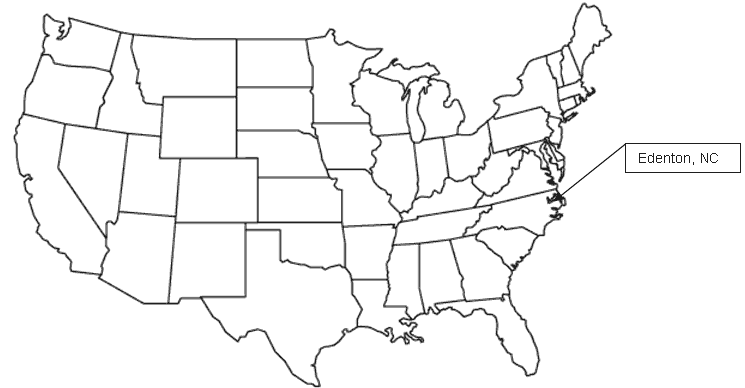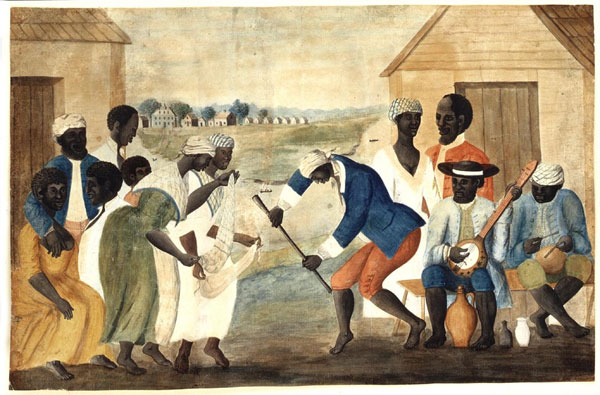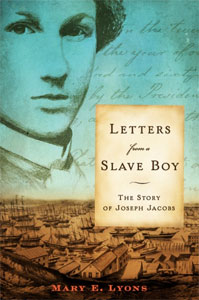|
 GO FIGURE
GO FIGURE
(answers at bottom of page—no cheating!)
Joseph’s gross pay for three years on the Ivy Ann whaler was $217.96, or
1/188 of the ship’s total profit. Use Joseph’s gross pay to figure the gross
profit for the owner of the Ivy Ann.
After the agent subtracted expenses, Joseph’s net pay was $57.96. Joseph worked on the
Ivy Ann for thirty-three months. What was his monthly net pay?
 TRAVELS WITH JOSEPH - EASY
TRAVELS WITH JOSEPH - EASY
(This activity requires computer skills. Don't be shy. Ask for help if you need
it.)
- Open a blank document in a word processing program on your computer.
- Copy and paste the United States map below into the blank document. Print the page.
- After reading Letters from a Slave Boy, label the towns, cities,
and states where Joseph lived in the United States. The first one is done for
you.
- Label the large oceans that are east and west of the United States.
- Draw a line that points toward Australia, which is off the map.
- Hint: The map should identify a total of one town, two cities, three states, two
oceans, and one continent.
- Beginning with Edenton, NC, draw lines that connect the places where Joseph lived.
 TRAVELS WITH JOSEPH – HARDER
TRAVELS WITH JOSEPH – HARDER
- At the bottom of the map or on the back, list the states you have labeled.
- For each state, briefly explain the slavery law or laws that frightened
Joseph. Refer to Letters from a Slave Boy as often as needed.
- Provide a date for each law. This can be the year in which state
legislators passed the law. Or you can use any year in which the law
was in effect.
- Think of a title that describes your map. Add the title at the top.
- You’ve worked hard. Now it’s show-off time. Explain your map
to an audience of friends, teachers, or family.

 JOSEPH'S
BANJO JOSEPH'S
BANJO
- In the painting below, an enslaved African American plays a gourd banjo.
This stringed instrument is similar to ones played in Africa. You could
even say that it is the great-great granddaddy of banjos played in
America today. Find a picture of a modern banjo and compare the two
instruments. List the ways in which they are alike.
- What other African instrument can you see in the picture?

The Old Plantation, artist unknown
Abby Aldrich Rockefeller Museum, Williamsburg, Virginia
http://www.history.org/history/museums/abby_art.cfm
- Joseph learns a tune called Roustabout. This old-time African-American song
has different names and various lyrics, depending on who plays it.
Click to hear a 30-second version by Dink Roberts, an African-American banjo player
from North Carolina.
You can hear the entire song on Black Banjo Songsters of North Carolina and
Virginia. The CD is available from
Smithsonian Folkways Recordings.
 WANT A
CHALLENGE? WANT A
CHALLENGE?
As Joseph learned in Boston, the popularity of African-American banjo tunes
led to the rise of racist minstrel shows. Professor Eric Lott from the
University of Virginia explains the history of minstrelsy in “Black
Face Minstrelsy: Past and Present.” Before
reading the text, review the meaning and pronunciation of:
caricature
malapropism
impediments
syncretism
percussive
commodified
capitalism
For a video of Professor Lott’s talk, click
here and
scroll down to his photo. Then click on the box underneath labeled
“video.” (Use the slider to skip the 60-second introduction.)
After hearing and/or watching the talk, answer these questions:
- Why did low-paid white workers call themselves “wage slaves”?
- Why were minstrel shows popular with white workers?
- Who were the Lords of the Loom?
- Who were the Lords of the Lash?
 WANT ANOTHER
CHALLENGE? GO FOR IT! WANT ANOTHER
CHALLENGE? GO FOR IT!
Read two books that Professor Lott mentioned in his talk.
Blacking Up: The Minstrel Show in American Culture by Robert Toll,
1974.
Black Reconstruction by W.E.B. Dubois, 1935.
 WHO
WERE THE NISENAN? WHO
WERE THE NISENAN?
(pronounced NEE suh nahn)
When Joseph is in California he meets a young Nisenan woman. Click
here to
learn more about the Nisenan, a group of Native Americans almost destroyed
by the California gold rush.
Click here to
see an early photograph of a Nisenan man.
|



